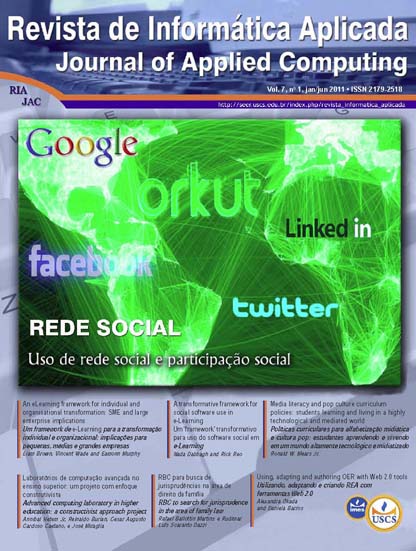A Transformative Framenwork for Social Software use in e-Learning Um 'Framework' Transformativo para uso do Software Social em e-Learning
DOI:
https://doi.org/10.13037/ria.vol7n1.1654Keywords:
software social, software educacional, e-learningAbstract
Este artigo irá descrever as bases teóricas do uso de um quadro em 3 níveis enraizado nos princípios de aprendizagem social; ilustrar como esse quardro pode ser aplicado a um conjunto básico de ferramentas de software educacional social; e fornecer um exemplo detalhado de como essa estrutura pode ser aplicada a wikis em um contextro de e-learningDownloads
References
CORMIER, D. Rhizomatic education: Community as curriculum. Innovate 4(5). Retrieved July 2, 2008, from http://www.innovateonline.info/index.php?view=article&id=550
DABBAGH, N., & REO, R. Back to the future: Tracing the roots and learning affordances of social software. In: M.J.W. Lee and C. McLoughlin (Eds.), Web 2.0-based e-Learning: Applying social informatics for tertiary teaching (pp. 1-20). Hershey, PA: IGI Global, 2011.
FRIELICK, S. Beyond constructivism: An ecological approach to e-learning. In: R. Atkinson, C. McBeath, D. Jonas-Dwyer, & R. Phillips (Eds.), Beyond the comfort zone: Proceedings of the 21st ASCILITE Conference (pp. 328-332). Perth, WA: University of Western Australia, 2004. Available at: http://www.ascilite.org.au/conferences/perth04/procs/pdf/frielick.pdf
GUNAWARDENA, C.; LOWE, C., & ANDERSON, T. Analysis of a global online debate and the development of an interaction analysis model for examining social building of knowledge in computer conferencing. Journal of Educational Computing Research, 17(4), 397-431, 1997.
LAURILLARD, D. Rethinking university teaching: A framework for the effective use of educational technology. New York: Routledge.
OBASANJO, D. (2004, October 5). Social software is the platform of the future. Retrieved October 10, 2007, from http://98.232.48.79/weblog/2004/10/06/SocialSoftwareIsThePlatform OfTheFuture.aspx
O'REILLY, T. (2007, July 17). Levels of the game: the hierarchy of web 2.0 applications. O'Reilly Radar. Retrieved January 23, 2008, from http://radar.oreilly.com/archives/2006/07/levels_of_the_game.html
SALMON, G. E-moderating: The key to teaching and learning online (2nd ed.). London: Routledge, 2004.
SCLATER, N. Web 2.0, personal learning environments, and the future of learning management systems. Boulder, CO: EDUCAUSE Center for Applied Research (ECAR). Available at http://www.educause.edu/ecar, 2008.
SESSUM, C. (2006, January 21). Notes on the significance of the emergence of blogs and wikis. Retrieved October 12, 2006, from http://eduspaces.net/csessums/weblog/6172.html
WILEY, D., & EDWARDS, E.K. (2002). Online self-organizing social systems: The decentralized future of online learning. Retrieved July 7, 2008, from http://opencontent.org/docs/ososs.pdf.
Downloads
Published
Issue
Section
License
Copyright (c) 2012 Nada Dabbagh, Rick Reo

This work is licensed under a Creative Commons Attribution-NonCommercial-ShareAlike 4.0 International License.
Os autores que publicam trabalhos na RIA estão de acordo com os seguintes termos:
- Autores mantêm seus direitos autorais e concedem à RIA o direito à primeira publicação. Admite-se o compartilhamento do referido trabalho, desde que seja reconhecida sua autoria e publicação inicial nesta revista.
- Autores podem fechar contratos adicionais separadamente, para distribuição não exclusiva da versão do trabalho publicado na RIA, com reconhecimento de sua autoria e publicação inicial nesta revista.
- Autores podem publicar e distribuir seu trabalho online, antes ou durante o processo editorial.


